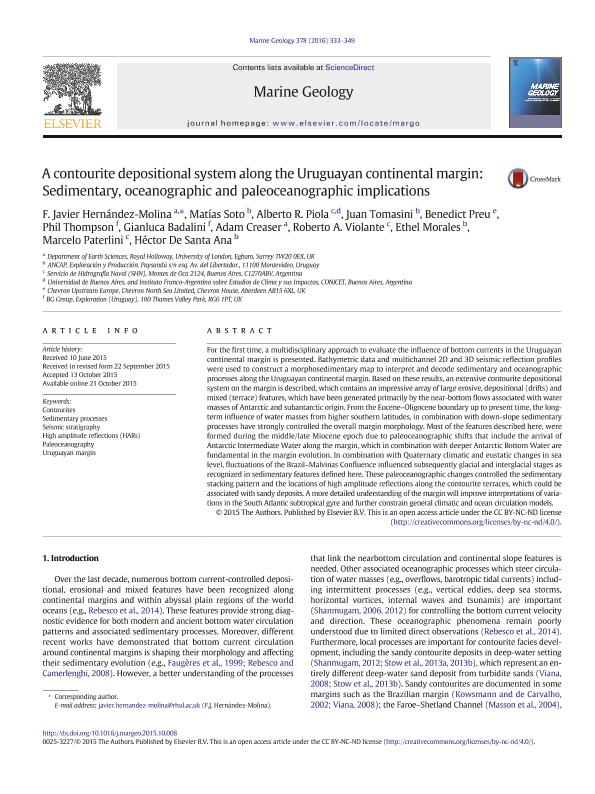Mostrar el registro sencillo del ítem
dc.contributor.author
Hernandez Molina, F.Javier
dc.contributor.author
Soto, Matias
dc.contributor.author
Piola, Alberto Ricardo

dc.contributor.author
Tomasini, Juan
dc.contributor.author
Preu, Benedict
dc.contributor.author
Thompson, Phil
dc.contributor.author
Baldini, Gianluca
dc.contributor.author
Creaser, Adam
dc.contributor.author
Violante, Roberto Antonio

dc.contributor.author
Morales, Ethel
dc.contributor.author
Paterlini, Marcelo
dc.contributor.author
De Santa Ana, Hector
dc.date.available
2018-04-27T19:39:26Z
dc.date.issued
2016-08
dc.identifier.citation
Hernandez Molina, F.Javier; Soto, Matias; Piola, Alberto Ricardo; Tomasini, Juan; Preu, Benedict; et al.; A contourite depositional system along the Uruguayan continental margin: sedimentary, oceanographic and paleoceanographic implications; Elsevier Science; Marine Geology; 378; 8-2016; 333-349
dc.identifier.issn
0025-3227
dc.identifier.uri
http://hdl.handle.net/11336/43741
dc.description.abstract
For the first time, a multidisciplinary approach to evaluate the influence of bottom currents in the Uruguayan continental margin is presented. Bathymetric data and multichannel 2D and 3D seismic reflection profiles were used to construct a morphosedimentary map to interpret and decode sedimentary and oceanographic processes along the Uruguayan continental margin. Based on these results, an extensive contourite depositional system on the margin is described, which contains an impressive array of large erosive, depositional (drifts) and mixed (terrace) features, which have been generated primarily by the near-bottom flows associated with water masses of Antarctic and subantarctic origin. From the Eocene–Oligocene boundary up to present time, the long-term influence of water masses from higher southern latitudes, in combination with down-slope sedimentary processes have strongly controlled the overall margin morphology. Most of the features described here, were formed during the middle/late Miocene epoch due to paleoceanographic shifts that include the arrival of Antarctic Intermediate Water along the margin, which in combination with deeper Antarctic Bottom Water are fundamental in the margin evolution. In combination with Quaternary climatic and eustatic changes in sea level, fluctuations of the Brazil–Malvinas Confluence influenced subsequently glacial and interglacial stages as recognized in sedimentary features defined here. These paleoceanographic changes controlled the sedimentary stacking pattern and the locations of high amplitude reflections along the contourite terraces, which could be associated with sandy deposits. A more detailed understanding of the margin will improve interpretations of variations in the South Atlantic subtropical gyre and further constrain general climatic and ocean circulation models.
dc.format
application/pdf
dc.language.iso
eng
dc.publisher
Elsevier Science

dc.rights
info:eu-repo/semantics/openAccess
dc.rights.uri
https://creativecommons.org/licenses/by-nc-sa/2.5/ar/
dc.subject
Sedimentary Processes
dc.subject
Seismic Stratigraphy
dc.subject
High Amplitude Reflections
dc.subject
Paleoceanography
dc.subject
Contourites
dc.subject
Uruguayan Margin
dc.subject.classification
Meteorología y Ciencias Atmosféricas

dc.subject.classification
Ciencias de la Tierra y relacionadas con el Medio Ambiente

dc.subject.classification
CIENCIAS NATURALES Y EXACTAS

dc.title
A contourite depositional system along the Uruguayan continental margin: sedimentary, oceanographic and paleoceanographic implications
dc.type
info:eu-repo/semantics/article
dc.type
info:ar-repo/semantics/artículo
dc.type
info:eu-repo/semantics/publishedVersion
dc.date.updated
2018-04-27T14:01:12Z
dc.journal.volume
378
dc.journal.pagination
333-349
dc.journal.pais
Países Bajos

dc.journal.ciudad
Amsterdam
dc.description.fil
Fil: Hernandez Molina, F.Javier. University of London; Reino Unido
dc.description.fil
Fil: Soto, Matias. ANCAP; Uruguay
dc.description.fil
Fil: Piola, Alberto Ricardo. Consejo Nacional de Investigaciones Científicas y Técnicas; Argentina. Ministerio de Defensa. Armada Argentina. Servicio de Hidrografía Naval; Argentina. Universidad de Buenos Aires; Argentina. Instituto Franco-Argentino; Argentina
dc.description.fil
Fil: Tomasini, Juan. ANCAP; Uruguay
dc.description.fil
Fil: Preu, Benedict. Chevron Upstream Europe; Reino Unido
dc.description.fil
Fil: Thompson, Phil. BG Group; Reino Unido
dc.description.fil
Fil: Baldini, Gianluca. BG Group; Reino Unido
dc.description.fil
Fil: Creaser, Adam. University of London; Reino Unido
dc.description.fil
Fil: Violante, Roberto Antonio. Ministerio de Defensa. Armada Argentina. Servicio de Hidrografía Naval; Argentina
dc.description.fil
Fil: Morales, Ethel. ANCAP; Uruguay
dc.description.fil
Fil: Paterlini, Marcelo. Ministerio de Defensa. Armada Argentina. Servicio de Hidrografía Naval; Argentina
dc.description.fil
Fil: De Santa Ana, Hector. ANCAP; Uruguay
dc.journal.title
Marine Geology

dc.relation.alternativeid
info:eu-repo/semantics/altIdentifier/doi/http://dx.doi.org/10.1016/j.margeo.2015.10.008
dc.relation.alternativeid
info:eu-repo/semantics/altIdentifier/url/https://www.sciencedirect.com/science/article/pii/S0025322715300487
Archivos asociados
